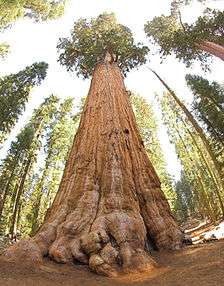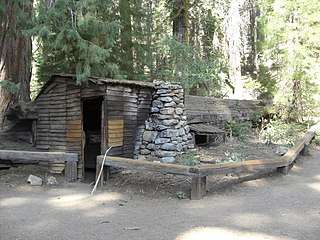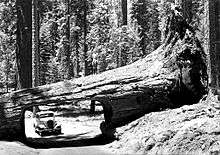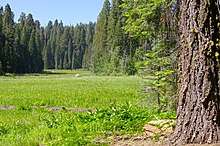Sequoia National Park
Sequoia National Park is an American national park in the southern Sierra Nevada east of Visalia, California. The park was established on September 25, 1890 to protect 404,064 acres (631 sq mi; 163,519 ha; 1,635 km2)[1] of forested mountainous terrain. Encompassing a vertical relief of nearly 13,000 feet (4,000 m), the park contains the highest point in the contiguous United States, Mount Whitney, at 14,505 feet (4,421 m) above sea level. The park is south of, and contiguous with, Kings Canyon National Park; both parks are administered by the National Park Service together as the Sequoia and Kings Canyon National Parks. UNESCO designated the areas as Sequoia-Kings Canyon Biosphere Reserve in 1976.[3]
| Sequoia National Park | |
|---|---|
IUCN category II (national park) | |
 The General Sherman Tree, the largest tree in the world. | |
 Location in California  Location in the United States | |
| Location | Tulare County, California, United States |
| Nearest city | Visalia, California |
| Coordinates | 36°33′53″N 118°46′24″W |
| Area | 404,064 acres (1,635.19 km2)[1] |
| Established | September 25, 1890 |
| Visitors | 1,229,594 (in 2018)[2] |
| Governing body | National Park Service |
| Website | www |
The park is notable for its giant sequoia trees, including the General Sherman tree, the largest tree on Earth. The General Sherman tree grows in the Giant Forest, which contains five of the ten largest trees in the world. The Giant Forest is connected by the Generals Highway to Kings Canyon National Park's General Grant Grove, home of the General Grant tree among other giant sequoias. The park's giant sequoia forests are part of 202,430 acres (316 sq mi; 81,921 ha; 819 km2) of old-growth forests shared by Sequoia and Kings Canyon National Parks.[4] The parks preserve a landscape that still resembles the southern Sierra Nevada before Euro-American settlement.[5]
Front country
Many park visitors enter Sequoia National Park through its southern entrance near the town of Three Rivers at Ash Mountain at 1,700 ft (520 m) elevation. The lower elevations around Ash Mountain contain the only National Park Service-protected California Foothills ecosystem, consisting of blue oak woodlands, foothills chaparral, grasslands, yucca plants, and steep, mild river valleys. The region is also home to abundant wildlife: bobcats, foxes, ground squirrels, rattlesnakes, and mule deer are commonly seen in this area, and more rarely, reclusive mountain lions and the Pacific fisher are seen as well. The last California grizzly was killed in this park in 1922 (at Horse Corral Meadow).[6] The California Black Oak is a key transition species between the chaparral and higher elevation conifer forest.[7]
At higher elevations in the front country, between 5,500 and 9,000 feet (1,700 and 2,700 m) in elevation, the landscape becomes montane forest-dominated coniferous belt. Found here are Ponderosa, Jeffrey, sugar, and lodgepole pine trees, as well as abundant white and red fir. Found here too are the giant sequoia trees, the most massive living single-stem trees on earth. Between the trees, spring and summer snowmelts sometimes fan out to form lush, though delicate, meadows. In this region, visitors often see mule deer, Douglas squirrels, and American black bears, which sometimes break into unattended cars to eat food left by careless visitors. There are plans to reintroduce the bighorn sheep to this park.[8]
Back country

The vast majority of the park is roadless wilderness; no road crosses the Sierra Nevada within the park's boundaries. 84 percent of Sequoia and Kings Canyon National Parks is designated wilderness[9] and is accessible only by foot or by horseback. The majority was designated Sequoia-Kings Canyon Wilderness in 1984[10] and the southwest portion was protected as John Krebs Wilderness in 2009.[11]
Sequoia's backcountry offers a vast expanse of high-alpine wonders. Covering the highest-elevation region of the High Sierra, the backcountry includes Mount Whitney on the eastern border of the park, accessible from the Giant Forest via the High Sierra Trail. On a traveler's path along this 35-mile (56 km) backcountry trail, one passes through about 10 miles (16 km) of montane forest before reaching the backcountry resort of Bearpaw Meadow, just short of the Great Western Divide.
Continuing along the High Sierra Trail over the Great Western Divide via Kaweah Gap, one passes from the Kaweah River Drainage, with its characteristic V-shaped river valleys, and into the Kern River drainage, where an ancient fault line has aided glaciers in the last ice age to create a U-shaped canyon that is almost perfectly straight for nearly 20 miles (32 km). On the floor of this canyon, at least two days hike from the nearest road, is the Kern Canyon hot spring, a popular resting point for weary backpackers. From the floor of Kern Canyon, the trail ascends again over 8,000 ft (2,400 m) to the summit of Mount Whitney. At Mount Whitney, the High Sierra Trail meets with the John Muir Trail and the Pacific Crest Trail, which continue northward along the Sierra crest and into the backcountry of Kings Canyon National Park.
Human history
The area which now comprises Sequoia National Park was first home to "Monachee" (Western Mono) Native Americans, who resided mainly in the Kaweah River drainage in the Foothills region of the park, though evidence of seasonal habitation exists as high as the Giant Forest. In the summertime, Native Americans would travel over the high mountain passes to trade with tribes to the East. To this day, pictographs can be found at several sites within the park, notably at Hospital Rock and Potwisha, as well as bedrock mortars used to process acorns, a staple food for the Monachee people.

By the time the first European settlers arrived in the area, smallpox had already spread to the region, decimating Native American populations. The first European settler to homestead in the area was Hale Tharp, who famously built a home out of a hollowed-out fallen giant sequoia log in the Giant Forest next to Log Meadow. Tharp allowed his cattle to graze the meadow, but at the same time had a respect for the grandeur of the forest and led early battles against logging in the area. From time to time, Tharp received visits from John Muir, who would stay at Tharp's log cabin. Tharp's Log can still be visited today in its original location in the Giant Forest.
However, Tharp's attempts to conserve the giant sequoias were at first met with only limited success. In the 1880s, white settlers seeking to create a utopian society founded the Kaweah Colony, which sought economic success in trading Sequoia timber. However, Giant Sequoia trees, unlike their coast redwood relatives, were later discovered to splinter easily and therefore were ill-suited to timber harvesting, though thousands of trees were felled before logging operations finally ceased.
The National Park Service incorporated the Giant Forest into Sequoia National Park in 1890, the year of its founding, promptly ceasing all logging operations in the Giant Forest. The park has expanded several times over the decades to its present size; one of the most recent expansions occurred in 1978, when grassroots efforts, spearheaded by the Sierra Club, fought off attempts by the Walt Disney Corporation to purchase a high-alpine former mining site south of the park for use as a ski resort. This site known as Mineral King was annexed to the park. Its name dates back to early 1873 when the miners in the area formed the Mineral King Mining District.[12] Mineral King is the highest-elevation developed site within the park and a popular destination for backpackers.
Climate
According to the Köppen climate classification system, Sequoia National Park encompasses five climate types listed here from highest to lowest elevation; Tundra (ET), Mediterranean-influenced Subarctic climate (Dsc), Mediterranean-influenced warm-summer Humid continental climate (Dsb), Warm-summer Mediterranean climate (Csb), and Hot-summer Mediterranean climate (Csa). According to the United States Department of Agriculture, the Plant Hardiness zone at Giant Forest Visitor Center (6,444 ft (1,964 m)) is 8a with an average annual extreme minimum temperature of 12.0 °F (−11.1 °C).[13]
| Climate data for Giant Forest Visitor Center, Sequoia National Park. Elev: 5646 ft (1721 m) | |||||||||||||
|---|---|---|---|---|---|---|---|---|---|---|---|---|---|
| Month | Jan | Feb | Mar | Apr | May | Jun | Jul | Aug | Sep | Oct | Nov | Dec | Year |
| Average high °F (°C) | 47.2 (8.4) |
47.7 (8.7) |
50.5 (10.3) |
55.0 (12.8) |
63.8 (17.7) |
72.4 (22.4) |
80.1 (26.7) |
80.3 (26.8) |
74.5 (23.6) |
64.3 (17.9) |
53.0 (11.7) |
45.9 (7.7) |
61.3 (16.3) |
| Daily mean °F (°C) | 38.0 (3.3) |
38.2 (3.4) |
40.7 (4.8) |
44.6 (7.0) |
52.5 (11.4) |
60.6 (15.9) |
68.4 (20.2) |
67.7 (19.8) |
62.3 (16.8) |
53.5 (11.9) |
43.8 (6.6) |
37.9 (3.3) |
50.8 (10.4) |
| Average low °F (°C) | 28.9 (−1.7) |
28.8 (−1.8) |
31.0 (−0.6) |
34.3 (1.3) |
41.3 (5.2) |
48.8 (9.3) |
56.7 (13.7) |
55.2 (12.9) |
50.2 (10.1) |
42.6 (5.9) |
34.6 (1.4) |
29.8 (−1.2) |
40.2 (4.6) |
| Average precipitation inches (mm) | 7.59 (193) |
7.16 (182) |
6.81 (173) |
3.61 (92) |
1.78 (45) |
0.67 (17) |
0.33 (8.4) |
0.14 (3.6) |
0.71 (18) |
1.96 (50) |
4.32 (110) |
6.11 (155) |
41.19 (1,046) |
| Average relative humidity (%) | 48.3 | 61.7 | 64.9 | 61.5 | 56.5 | 47.3 | 41.7 | 38.6 | 38.1 | 42.6 | 49.3 | 50.4 | 50.0 |
| Average dew point °F (°C) | 20.2 (−6.6) |
26.2 (−3.2) |
29.8 (−1.2) |
32.2 (0.1) |
37.5 (3.1) |
40.4 (4.7) |
44.2 (6.8) |
41.6 (5.3) |
36.4 (2.4) |
31.3 (−0.4) |
26.0 (−3.3) |
21.1 (−6.1) |
32.3 (0.2) |
| Source: PRISM Climate Group[14] | |||||||||||||
Geology
Sequoia National Park contains a significant portion of the Sierra Nevada. The park's mountainous landscape includes the tallest mountain in the contiguous United States, Mount Whitney, which rises to 14,505 feet (4,421 m) above sea level.[15] The Great Western Divide parallels the Sierran crest and is visible at various places in the park, for example, Mineral King, Moro Rock, and the Giant Forest. Peaks in the Great Western Divide rise to more than 12,000 feet (3,700 m). Deep canyons lie between the mountains, including Tokopah Valley above Lodgepole, Deep Canyon on the Marble Fork of the Kaweah River, and Kern Canyon in the park's backcountry, which is more than 5,000 feet (1,500 m) deep for 30 miles (48 km).[16]

Most of the mountains and canyons in the Sierra Nevada are composed of granitic rocks. These rocks, such as granite, diorite and monzonite, formed when molten rock cooled far beneath the surface of the earth. The molten rock was the result of a geologic process known as subduction. Powerful forces in the earth forced the landmass under the waters of the Pacific Ocean beneath and below an advancing North American Continent. Super-hot water driven from the subducting ocean floor migrated upward and melted rock as it proceeded. This process took place during the Cretaceous Period, 100 million years ago. Granitic rocks have a speckled salt-and-pepper appearance because they contain various minerals including quartz, feldspars and micas. Valhalla, or the Angel Wings, are prominent granitic cliffs that rise above the headwaters of the Middle Fork of the Kaweah River.[16]
The Sierra Nevada is a young mountain range, probably not more than 10 million years old. Forces in the earth, probably associated with the development of the Great Basin, forced the mountains to rise. During the last 10 million years, at least four ice ages have coated the mountains in a thick mantle of ice. Glaciers form and develop during long periods of cool and wet weather. Glaciers move very slowly through the mountains, carving deep valleys and craggy peaks. The extensive history of glaciation within the range and the erosion resistant nature of the granitic rocks that make up most of the Sierra Nevada have together created a landscape of hanging valleys, waterfalls, craggy peaks, alpine lakes and glacial canyons.[16]
Park caves, like most caves in the Sierra Nevada of California, are mostly solutional caves dissolved from marble. Marble rock is essentially limestone that was metamorphosed by the heat and pressure of the formation and uplift of the Sierra Nevada Batholith. The batholith's rapid uplift over the past 10 million years led to a rapid erosion of the metamorphic rocks in the higher elevations, exposing the granite beneath; therefore, most Sierra Nevada caves are found in the middle and lower elevations (below 7,000 ft or 2,100 m), though some caves are found in the park at elevations as high as 10,000 ft (3,000 m) such as the White Chief cave and Cirque Cave in Mineral King. These caves are carved out of the rock by the abundant seasonal streams in the park. Most of the larger park caves have, or have had, sinking streams running through them.
The park contains more than 270 known caves, including Lilburn Cave which is California's longest cave with nearly 17 miles (27 km) of surveyed passages.[16] The only commercial cave open to park visitors is Crystal Cave, the park's second-longest cave at over 3.4 miles (5.5 km). Crystal Cave was discovered on April 28, 1918 by Alex Medley and Cassius Webster.[17] The cave is a constant 48 °F (9 °C), and is only accessible by guided tour.
Caves are discovered every year in the park with the most recently discovered major cave being Ursa Minor in August 2006.[18][19]
Flora and Fauna
According to the A. W. Kuchler U.S. Potential natural vegetation Types, Sequoia National Park encompasses five classifications listed here from highest to lowest elevation; Alpine tundra & barren vegetation type with an Alpine tundra vegetation form...Pinus contorta/ Subalpine zone vegetation type with a California Conifer Forest vegetation form...Abies magnifica vegetation type with a California Conifer Forest vegetation form...Mixed conifer vegetation type with a California Conifer Forest vegetation form...and Chaparral vegetation type with a California chaparral and woodlands vegetation form.[20]
Animals that inhabit this park are coyote, badger, black bear, bighorn sheep, deer, fox, cougar, eleven species of woodpecker, various species of turtle, three species of owl, opossum, various species of snake, wolverine, beaver, various species of frog, and muskrat.
Park attractions


In addition to hiking, camping, fishing, and backpacking, the following attractions are highlights with many park visitors:
- Sherman Tree Trail An 0.8-mile roundtrip paved trail that descends from the parking lot to the base of the General Sherman tree and meanders through a grove of giant sequoia trees.
- Tunnel Log is a fallen giant sequoia tree in Sequoia National Park. The tree, which measured 275 feet (84 m) tall and 21 feet (6.4 m) in diameter, fell across a park road in 1937 due to natural causes. The following year, a crew cut an 8-foot (2.4 m) tall, 17-foot (5.2 m) wide tunnel through the trunk, making the road passable again.[21][22][23]
- Tokopah Falls The trail to Tokopah Falls starts just beyond the Marble Fork Bridge in Lodgepole Campground. It is an easy 1.7 mile (one way) walk along the Marble Fork of the Kaweah River to the impressive granite cliffs and waterfall of Tokopah Canyon. Tokopah Falls is 1,200 feet (365.8 meters) high, and is most impressive in early summer.
- Crescent Meadow is a small, sequoia-rimmed meadow in the Giant Forest region of Sequoia National Park. This sierran montane meadow marks the western terminus of the High Sierra Trail, which stretches from the meadow across the Great Western Divide to Mount Whitney. Pioneer Hale Tharp homesteaded in this and nearby Log Meadow. Conservationist John Muir visited this meadow many times and praised it highly calling it the "Gem of the Sierra". The meadow lies at the end of a three-mile paved road which leaves the Generals Highway near the Giant Forest Museum.
- Moro Rock is a granite dome located in the center of the park, at the head of Moro Creek, between Giant Forest and Crescent Meadow. A 400-step stairway, built in the 1930s by the Civilian Conservation Corps, is cut into and poured onto the rock, so that visitors can hike to the top. The stairway is listed on the National Register of Historic Places. The view from the rock encompasses much of the Park, including the Great Western Divide. It has an elevation of 6,725 feet (2,050 m).
- Campgrounds in the park include three in the foothills area: Potwisha (42 sites), Buckeye Flat (28 sites), and South Fork (10 sites). Four campgrounds are at higher, conifer-dominated elevations, ranging from 6,650 to 7,500 feet (2,000 to 2,300 m): Atwell Mill (21 sites), Cold Springs (40 sites), Lodgepole (214 sites), and Dorst Creek (204 sites).
- Giant Forest Museum offers information about giant sequoias and human history in the forest. The historic museum was built in 1928 by architect Gilbert Stanley Underwood.
See also
- African-American Heritage Sites
- Bibliography of the Sierra Nevada
- Buffalo Soldier
- Ecology of the Sierra Nevada
- Fauna of the Sierra Nevada
- List of largest giant sequoias
- List of national parks of the United States
- List of plants of the Sierra Nevada
- National Register of Historic Places listings in Sequoia-Kings Canyon National Parks
- Protected areas of the Sierra Nevada
References
- "Listing of acreage as of December 31, 2012". Land Resource Division, National Park Service. Retrieved 2013-09-22.
- "NPS Annual Recreation Visits Report". National Park Service. Retrieved 2019-03-11.
- "UNESCO - MAB Biosphere Reserves Directory". Retrieved 23 May 2016.
- Bolsinger, CL; Waddell, KL (1993). "Area of old-growth forests in California, Oregon, and Washington" (PDF). United States Forest Service, Pacific Northwest Research Station. Resource Bulletin PNW-RB-197. Retrieved 2012-03-07. Cite journal requires
|journal=(help) - Franklin, Jerry, F; Fites-Kaufmann, Jo Ann (1996). "Status of the Sierra Nevada". Assessment of Late-Successional Forests of the Sierra Nevada (III: Biological and Physical Elements of the Sierra Nevada ed.). Sierra Nevada Ecosystem Project. Final Report to Congress: 627–71. Archived from the original on 2012-12-12. Retrieved 2012-03-07. Cite journal requires
|journal=(help) - Grinnell, Joseph (1937). Fur Bearing mammals of California.
- Hogan, C. Michael (2008). Stromberg, Nicklas (ed.). "California Black Oak: Quercus kelloggii". GlobalTwitcher.com. Archived from the original on 2012-02-18. Retrieved 2012-03-07. Cite journal requires
|journal=(help) - US NPS. "Mammals".
- "Sequoia and Kings Canyon Wilderness". Sierra Nevada Wilderness Education Project. Archived from the original on 2008-10-12. Retrieved 2012-03-07.
- "Sequoia-Kings Canyon Wilderness". wilderness.net. Retrieved 2019-08-31.
- "John Krebs Wilderness". wilderness.net. Retrieved 2019-08-31.
- Jackson, Louise A. (1988). Beulah: A Biography of the Mineral King Valley of California. Tucson, Arizona: Westernlore Press. p. 18. ISBN 0-87026-065-0. OCLC 17830966.
- "USDA Interactive Plant Hardiness Map". United States Department of Agriculture. Retrieved 2019-07-18.
- "PRISM Climate Group, Oregon State University". www.prism.oregonstate.edu. Retrieved July 18, 2019.
- "Whitney". NGS data sheet. U.S. National Geodetic Survey.
-

- Despain, Joel (1995). "Crystal Cave: A Guidebook to the Underground World of Sequoia National Park". Sequoia Natural History Association. ISBN 1-878441-06-X. Cite journal requires
|journal=(help) - Squatriglia, Chuck (September 24, 2006). "Magical underground world". sfgate.com. San Francisco Chronicle. Archived from the original on November 3, 2007. Retrieved March 7, 2012.
- Blake de Pastino (September 26, 2006). "Photo in the News: Giant Crystal-Filled Cave Discovered in California". news.nationalgeographic.com. National Geographic Society. Retrieved June 6, 2018.
- "U.S. Potential Natural Vegetation, Original Kuchler Types, v2.0 (Spatially Adjusted to Correct Geometric Distortions)". Data Basin. Retrieved 2019-07-18.
- "Destination drive through trees". OhRanger.com. Retrieved January 9, 2017.
- "Where is the tree you can drive through?" (PDF). United States Forest Service. Retrieved January 10, 2017.
- "The Myth of the Tree You Can Drive Through". Sequoia & Kings Canyon. National Park Service. Retrieved January 10, 2017.
[The Wawona Tree] was the second standing sequoia to be tunneled (the first, a dead tree, still stands in the Tuolumne Grove in Yosemite).
External links
| Wikimedia Commons has media related to: |
| Wikivoyage has a travel guide for Sequoia National Park. |
- Official website

- Geologic Map of Southwestern Sequoia National Park – United States Geological Survey
- Virtual reality scenes in Sequoia National Park
- Lary M. Dilsaver and William C. Tweed, Challenge of the Big Trees – natural and human history of the park
- The short film Giant Sequoia (1979) is available for free download at the Internet Archive
